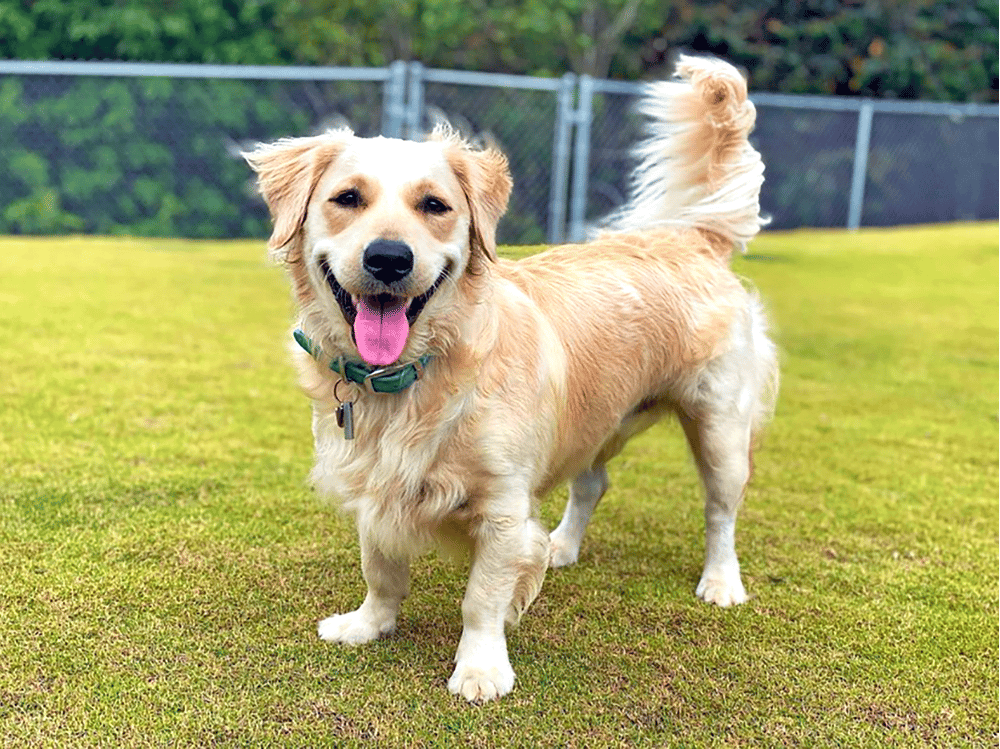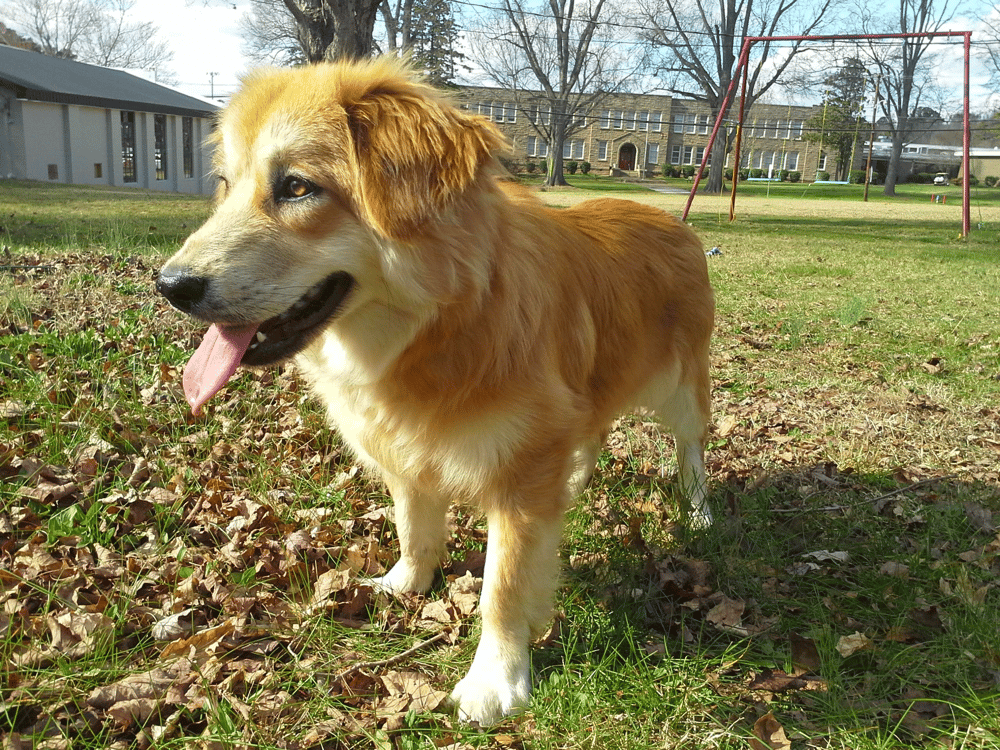Contents
- A Quick Look at the Corgi Retriever
- Breed History: How the Mixed Breed Came About
- Corgi Retriever Traits and Temperament
- What Does A Corgi Retriever Look Like?
- Corgi Retriever Expected Lifespan: A Few Bonus Years
- What Diet Should I Feed Corgi Retriever?
- The Exercise Requirements of a Corgi Retriever
- How Easily Trained is a Corgi Retriever?
- Possible Health Concerns of Corgi Retriever
- How Much Does A Corgi Retriever Cost?
- Conclusion
- Other Golden Retrievers Mixes
Have you been going down the list of Golden Retriever mixes to find the one that resonates with you? Look no further! The Corgi Retriever, a mix of a Golden Retriever and a Corgi, is a really great option if you want a dog that is smart, active, and will do well in an apartment setting. We are going to take a look at what to expect from a Corgi Golden mix such as appearance, lifestyle requirements, and possible health concerns.
A Quick Look at the Corgi Retriever
| Statistics of the Corgi Retriever | |
| Weight | 30-75 lb |
| Height | 10-18 inches (from paw to shoulder) |
| Coat Type | Double Coated |
| Coat Color | Red, gold, tan, white, brown, fawn, black |
| Amount of Shedding | Moderate to Heavy Shedding |
| Temperament | Intelligent, loyal, outgoing, stubborn, bold, affectionate, high-energy |
| Lifespan | 10-14 years |
Breed History: How the Mixed Breed Came About

Before we can delve into the Corgi Retriever, we need to discuss how they came about. First, we need to talk about the two parents’ breeds. Both the Golden Retriever and the Corgi have been around for hundreds of years.
Golden Retrievers were utilized as waterfowl Retrievers or gun dogs. They were bred for increased stamina and that familiar happy-go-lucky personality that everyone knows and loves.
There are two different types of Corgi, the Cardigan, and the Pembroke Welsh. While they have their own individual breed standards and expected personality traits, the two are very similar and pass on similar traits to the mixed breed. These dogs are known primarily as the Royal dogs of the British Queens.
Now, the Corgi Retriever is considered a “designer breed.” They were first seen in the 1990s in the United States. They are still a very new mixed breed and there are no current breeders pursuing a breed standard for them. As such, they can inherit just about any physical or behavioral trait from either parent breed.
Corgi Retriever Traits and Temperament

This particular mixed breed seems to repeatedly take the best traits from both parents. The Corgi Retriever tends to have that happy-go-lucky and goofy personality of the Golden Retriever. They can be very outgoing and friendly towards guests or strangers. These are definitely not going to be unassuming guard dogs – they like people too much.
That is not to say these dogs aren’t smart. Trust me, they are. These short-statured pups inherit their intelligence from their Corgi parent. Often, they are a bit too smart for their own good. They may even test the limits of their owners to see what they can get away with.
Thankfully, they are also high-energy and the mental stimulation can be combined with the physical stimulation of walks to keep them occupied. Corgi Retrievers get their energy level from the Golden Retriever parent.
While this specific crossbreed has the potential to be overly outgoing and friendly, they are definitely a “one-person dog.” They will pick their person and bond very closely with them. These dogs would be ideal for an individual who is living alone. However, this tendency towards codependency can sometimes lead to separation anxiety.
What Does A Corgi Retriever Look Like?

The Corgi Retriever is definitely not a dog known for their beauty. I’m sorry, but they aren’t. Since they retain the short legs and long body of the Corgi as well as the broad head of the Golden Retriever, they always seem to look a bit disproportionate.
Typically, this mixed breed will look primarily like a Golden but with itty bitty legs. They often have the thick feathery coat of the Golden Retriever, too. The coloring of the fur can vary, though. These dogs may appear golden, red, tan, white, brown, fawn, or even black. They may even have chest, face, or leg markings from their Corgi parent.
Corgi Retriever Expected Lifespan: A Few Bonus Years
Something else that the Corgi Retriever inherits from their Corgi parent is a longer lifespan. Larger dogs tend to live shorter lives and Goldens only have a lifespan of 10-12 years. The Corgi has an average lifespan of 10-14 years which it then passes on to its mixed-breed puppies. This crossbreed will be with you for about a decade and a half.
What Diet Should I Feed Corgi Retriever?
In order to keep them for that long, though, we do have to feed them an appropriate diet. Corgi Retrievers absolutely love to eat and, due to their body conformation, they will pack on pounds very quickly. The best diet for a Corgi Retriever is a weight management diet.
The most effective weight management diets are going to be from the three main brands that are recommended by veterinarians. These would be Purina, Hill’s Science Diet, and Royal Canin. Of these, Hill’s Science Diet Perfect Weight has been shown to be the most effective at weight loss and weight management.
Another thing to include in the diet of a Corgi Retriever would be joint supplements. While their short, stubby legs are adorable, they aren’t the most practical and issues will crop up quickly. Hopefully, by adding a joint supplement such as glucosamine chondroitin, you can give your pup a few extra years without joint pain. These can be started as early as 6 months to 1 year of age and there are no side effects.
The Exercise Requirements of a Corgi Retriever
Those short legs will also be a benefit to you, as the owner. Though a Corgi Retriever is a high-energy dog, they won’t require as long of a walk as a full-grown Golden. This is because every single Golden Retriever step is equal to two to three Corgi Retriever steps! These dogs should only require 1-2 walks per day, which is pretty standard.
Corgi Retrievers should not be allowed to jump up or down off of furniture at any time. These dogs inherit the long back of the Corgi and, as such, are prone to slipping a disc in their back. They can absolutely go on the furniture, just make sure that they have pet stairs or that you are lifting them.
The proper lifting technique of a Corgi Retriever or a similarly shaped dog is known as a “shepherd’s carry.” You know, like the “fireman’s carry”? This technique is executed by lifting the animal like a shepherd lifts a sheep. One arm scoops under the back legs so the animal is practically sitting on your arm. The second arm braces the animal at the chest. Lift with both arms simultaneously to alleviate strain on the spine.
Do not be worried if your dog pulls their front legs over the arm braced against their chest. Sometimes they feel like they have more purchases that way. During the initial lift, at least, you want the dog’s spine to remain as parallel to the floor as possible.
How Easily Trained is a Corgi Retriever?
Corgi Retrievers should be relatively easy to train depending on how smart they are. Sometimes, like a gifted child acting out in class because of boredom, a smart dog may test your patience as a trainer. They can also be adorably stubborn.
Though they may look cute while misbehaving, don’t let them get away with it as a puppy. It will be exceedingly difficult to train a behavior out later on that you have rewarded with laughter early on.
One of these behaviors that need to be trained out early is jumping. We’ve all seen that cute pose where small dogs will bounce on their hind legs to get their owner’s attention. Don’t allow that. This particular mixed breed has an extremely long and delicate spine and that type of jumping could be harmful to your dog.
Another thing to train out of your dog sooner rather than later is excessive barking. This is another form of attention-seeking that typically gets laughed off when they are smaller. If you allow this to get out of control, you’ll know the moment the neighbor comes home, the minute the mailman’s truck arrives on the street, and whether that pesky squirrel in the backyard is getting into your birdhouse again.
Corgi Retrievers can also be subject to separation anxiety. Since they are so loyal and particular about whom their person is, they can become overly attached. Make sure to spend time with your dog working on self-soothing behaviors (like chewing on a sturdy chew toy) and give them time in a separate room or in a crate to teach them some boundaries.
If you feel like your dog may be exhibiting signs of separation anxiety, it is not a bad idea to reach out to a dog trainer. An in-home dog trainer would be preferable, as that would allow them to give you and your dog methods and tools that will work in your space.
All in all, this specific mixed breed does not have many pitfalls when it comes to training. They don’t typically exhibit resource guarding or any other type of reactivity. As long as they are socialized young, they do well with children, guests, and other animals. If you want an easily trained dog that will keep you on your toes, this may be the right dog for you.
Possible Health Concerns of Corgi Retriever

Even the list of health concerns for this mixed breed is relatively short, though it may not look that way on paper. Compared to other breeds, this mix of health problems is practically nonexistent. There is an even split of concerns that could pass to the offspring from each parent breed.
One serious issue that can be inherited from the Golden Retriever is benign or cancerous lumps. It is well known in the veterinary field to check patients with a Golden Retriever parent for new and/or quick-growing masses. These can be dangerous or nothing to worry about.
If you find a new lump on your dog, monitor its size and growth until you can get into the veterinarian’s office. They will typically take a sample of the lump or biopsy it after removing it completely during a procedure (while under anesthesia) to determine the type of mass. Sometimes, these are benign, or non-harmful, and sometimes they are cancerous. If you notice something, it is always better to be safe than sorry.
Another probable health concern that comes from the Golden Retriever parent is the possibility of allergies. Dogs experience two types of allergies: either environmental or food. Symptoms of allergies may present as vomiting, diarrhea, skin lesions, excessive itching, ear infections, a yeasty smell, and more.
Again, if you see something out of the ordinary, bring your dog to the vet. Allergies can be alleviated with several different types of medications or treatments. Let the veterinarian determine what will work best for your pet so that they can be the most comfortable.
Another concern from the Golden Retriever side is hypothyroidism. This is a condition where the thyroid, a gland that produces chemicals involved in basic organ function, is operating incorrectly. An animal’s bloodwork would show low levels of T4 or thyroid production.
This condition would present with symptoms such as skin or fur problems, low heart rate, lethargy, and an increased appetite without any weight gain. This is a lifelong condition and can only be managed via chronic medication.
The Corgi does not contribute too many issues to their mixed breed offspring. There is a teeny tiny chance that if the Corgi parent is a purebred, they may pass on epilepsy or a seizure disorder. Since no practicing breeders are currently going out of their way to produce Corgi Retriever puppies, they should be safe from this disorder.
Another concern is only relevant depending on what type of Corgi the parent dog is. The Pembroke Welsh Corgi can occasionally have a bleeding disorder called Von Willebrand Disease. This can cause bleeding or bruising with the slightest injury due to the blood’s inability to clot.
Again, it would be very rare to see this in a Corgi Retriever as it is already rare to see in a Corgi. Any responsible breeder would be aware that their dog had this disease. Make sure to do your research before buying or adopting your dog. It is recommended that you take your dog in to see the veterinarian within the first 1-2 weeks of bringing them home to hopefully flag any health concerns before you become too attached.
We have already touched a bit on the Corgi Retriever’s proclivity toward obesity. Keep an eye on your pet’s weight by placing them on the scale at home or, if they won’t stand on it, picking them up and standing on the scale yourself. Subtract your weight from that number and you will be left with the dog’s weight.
If this is still too much of a hassle, bring your dog to the vet and let them weigh the dog. While you are there, ask for a target weight so you know how much to feed your pet based on the food bag’s “Feeding Guide.”
Keeping your pet trim and in good shape is not merely about aesthetics. When a dog puts on too much weight, especially one that has such short legs, the extra weight can put unnecessary pressure on the joints. This can cause one of the other issues which are early onset arthritis.
Arthritis is inflammation of the cartilage in the joints which can make it uncomfortable to get up and down off of the floor or painful to walk around. Both the Corgi and the Golden Retriever are notorious for this issue.
As we’ve already touched on, adding a joint supplement to your pet’s diet will only help to give your pet a bit more time. Hopefully, it will also slow down the progression of arthritis.
A joint supplement may even help with alleviating pain caused by hip and elbow dysplasia. Again, both parent breeds are known for this. Hip and elbow dysplasia occurs when the socket that the corresponding bones are supposed to fit in is irregularly shaped, causing joint damage over time.
This is typically evident when your pet starts to walk with a bow-legged stance. They may even have this irregular bone formation from the very beginning. The possibility of hip or elbow dysplasia is just one more reason to bring your dog to the vet early on.
Another complication that your veterinarian might catch before you do is called cataracts. This is when a film develops within the eye, blurring and then impeding your dog’s sight. This usually happens with age and occasionally leads to complete blindness in one or both eyes.
The final health concern that comes courtesy of the Corgi parent is the delicate and lengthy spine. While these dogs are adorable when closer to the ground, their backs are fragile. They are very likely to slip a disc, which means that the cushion between the vertebrae (the bones of the spine) has either burst or degenerated.
This results in the vertebrae rubbing together or possibly can even cause a kink in the spinal cord. This damage to the spinal cord can cause symptoms such as paralysis in the hind limbs and lower back.
There is a surgical correction available but it is extremely expensive and sometimes does not help the dog regain functionality in the hind end. A slipped disc is extremely painful and can happen at any time with a long-backed dog.
How Much Does A Corgi Retriever Cost?
The vet bills alone will run you into the thousands if you are not careful. These are a dog that an owner should most definitely have pet insurance for. Preferably, this should happen as soon as possible.
In terms of food bills, they run on the less expensive side so if you are adequately prepared to welcome a dog into your home, there are no hidden food costs for these guys. Just be sure to keep the food bag out of reach, otherwise, you will be spending money on another food bag and possibly a medical bill because they plowed through it.
This mixed breed is not expensive, mostly because you won’t find a breeder. Your best bet to find a Corgi Retriever is to go through a shelter or a rescue specific to one of the two breeds. Petfinder.com is a website that allows you to search multiple breeds while looking through adoptable dogs near you.
Conclusion
While they may be difficult to find in actuality, this particular mixed breed would make a wonderful family pet. They would probably do best as a pet for an individual. They also have great potential as city or apartment pets due to their size and a relatively small need for activity.
Always make sure to pick these dogs up correctly and teach them to use pet stairs rather than jump on and off your furniture. They are really smart dogs, so keep them occupied with training and new adventures.
Again, there is no shame in seeking out further resources. Sometimes, we may need a veterinarian’s perspective or a helping hand from a dog trainer or behaviorist. If you feel like you need assistance in giving your dog the best quality of life, reach out to a professional before you become overwhelmed.
A Corgi Retriever would probably do best as a second or third dog rather than someone’s first dog. However, as long as you are willing to put in the work with them, these dogs are capable of being a great addition to the family!
Other Golden Retrievers Mixes
- Goldendoodle (Golden Retriever Poodle Mix)
- Goldador (Golden Retriever Labrador Mix)
- Golden Collie (Golden Retriever Border Collie Mix)
- Golden Boxer (Golden Retriever Boxer Mix)
- Australian Retriever (Australian Shepherd Golden Retriever Mix)
- Golden Mountain Dog (Golden Retriever Bernese Mountain Dog Mix)
- Corgi Retriever (Golden Retriever Corgi Mix)
- Golden Retriever Husky Mix: Active, Energetic, and Companionable Dog
- Golden Pyrenees (Golden Retriever Great Pyrenees Mix)
- Golden Chi (Golden Retriever Chihuahua Mix)
- Goldmation (Golden Retriever Dalmatian Mix)
